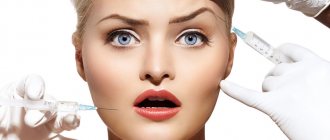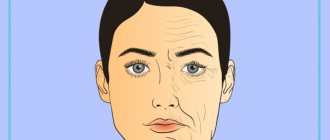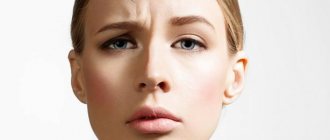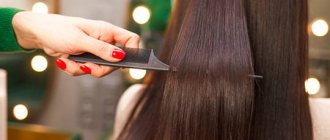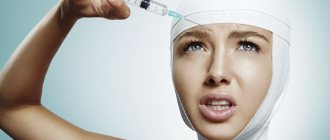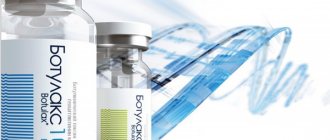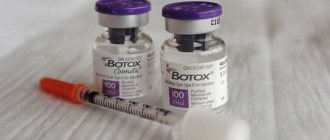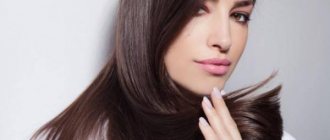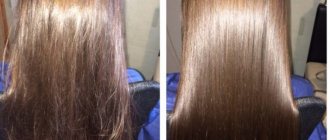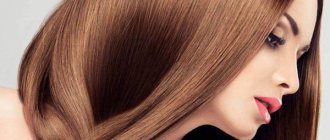I have been given the image of being against injections, but this is not entirely true. I am not against injections, I am against injections “for growth” and abuse. You need to do something for which there are real, not hypothetical, prerequisites.
“I’m 32, maybe it’s time to take drugs? On the other hand, I was told that you get hooked on the needle, and the later you start, the better. So, should we now wait until 60?”
In fact, the invention of “beauty injections” is a revolution in cosmetology. Thanks to them, we have reconsidered what methods have the right to be called effective. For cosmetologists, the emergence of Botox and hyaluronic acid injections is the same as for dentists the introduction of implantation and metal-ceramic prosthetics. You can, of course, still insert gold teeth into patients, but in general they don’t wear them anymore. You can, of course, still walk around with deep wrinkles on your forehead, but actually now there is Botox.
The problem is not that injections are evil. The problem is that many cosmetologists and their patients are so carried away by these injections for “preventative purposes” that they remind me of children from low-income families who were sewn dresses to grow into when they were children.
Anti-wrinkle toxin
Botox is the name of the drug produced. It is based on botulinum neurotoxin type A, which is secreted by the organisms Clostridium botulinum in the laboratory and human serum albumin. The drug is used in cosmetology and aesthetic medicine to eliminate facial wrinkles, correct drooping eyebrows, corners of the lips, crow's feet, and signs of hyperhidrosis.
The toxin is injected under the skin using a thin needle. Under its action, muscles relax and wrinkles smooth out. The effect appears 2-3 days after the procedure and lasts from 4 to 9 months. Some clients claim that the results last up to 2 years, but this period may only be due to muscle memory. Over time, the wrinkles will return, and the procedure will need to be repeated.
The dangers of Botox and contraindications
Botulinum toxin is, in most cases, well tolerated. Rare unusual reactions to the drug are determined by a person's genetic predisposition. In approximately 1% of people treated with Botox, the body produces antibodies to the toxin. This causes undesirable consequences. These include:
- migraine-type headache;
- nausea;
- temporary drooping of the eyelid, displacement of the eyebrows;
- double vision, blurred vision, blurred vision;
- weakness of the neck muscles;
- stitching pain in shoulders;
- runny nose;
- hoarse voice;
- skin rash;
- feeling of weakness, fatigue;
- dry mouth.
Before conducting a course of injections, the cosmetologist finds out the contraindications for each case. Botox is prohibited for allergy sufferers and people with skin diseases. Other prohibitions:
- chronic blood diseases;
- acute infections of any kind;
- severe ophthalmological diseases;
- pathologies of the facial muscles;
- alcoholism.
Botulinum toxin should not be administered to pregnant and lactating women. The course is postponed to another time if the client is taking antibiotics, muscle relaxants, or medications that slow down blood clotting.
How to achieve maximum effect
The best results can only be achieved with correct injections. Before performing the procedure, the cosmetologist asks the patient to frown, close his eyes, and grimace. These manipulations help identify areas with facial wrinkles and correctly place injection points.
The procedure is quick (up to 30 minutes) and painless.
By following these rules, you can increase the duration of the drug and reduce possible side effects:
- one week before your appointment, you should not drink alcohol, smoke, or take blood thinning medications;
- two to three days before the injections, it is recommended to start taking “Arnica”, which is a homeopathic medicine and reduces the likelihood of hemorrhages;
- you should pay attention to the menstrual cycle: the procedure is prohibited during menstruation;
- Before visiting a cosmetologist, it is recommended to drink a cup of strong sweet tea and eat a slice of dark chocolate; it is not recommended to come to the procedure hungry.
❤
Aftercare
Botulinum therapy is not accompanied by long-term rehabilitation. After injections, you do not need to change your lifestyle, just follow some rules.
To ensure uniform distribution of the substance during the first hours, you cannot:
- tilt;
- take a horizontal position;
- massage and touch your face with your hands;
- wash with hot water.
Further, the following restrictions must be observed:
- avoid exposure to the sun;
- avoid sudden changes in temperature;
- do not massage;
- do not injure the skin with aggressive means and procedures;
- do not drink alcohol;
- do not exercise;
- do not take medications (containing prostaglandin, low molecular weight dextran, and calcium channel blockers);
- sleep on a high pillow.
Is the drug dangerous?
Botox is a safe drug. The volume of the dangerous substance contained in the injection is negligible. The neurotoxin acts only in the area where the injection is given. The toxin does not accumulate in the body; after 21 days it is completely eliminated through the genitourinary system. The drug is not addictive because it is administered and works on new synapses each time. The dosage of the drug is selected individually.
Side effects or overdose are rare. The most common side effect is headache during the day after the procedure. This is fine.
Drooping eyebrows or changes in articulation develop not because the drug is dangerous, but because the cosmetologist violated the technique of administering or preparing the solution. Therefore, you need to take injections responsibly and visit only a specialist with a medical education who knows anatomy well.
Limit on number of procedures
There are no strict restrictions on the number of procedures for different ages. The results of the injections become noticeable within a few days, and the effect remains for several months. The results of Botox injections vary from person to person due to a number of reasons, and the need for repeat procedures also varies. Firstly, clients’ lifestyle influences: smoking and alcohol make them visit the clinic more often. Athletes are emotional people, so they also resort to procedures more often.
If the result is shorter in duration than expected, the procedure can be repeated no earlier than four months later. This is due to the fact that botulinum toxin still has harmful effects on the body.
When to start injections
The use of botulinum toxin is allowed for patients from 18 to 65 years of age. For people aged 21-25 years, cosmetologists recommend using a lighter version of the drug - “baby Botox” to correct the first wrinkles on the forehead or between the eyebrows.
It is recommended to start injecting Botox at the age of 25-35 years. Scientists note that the use of neurotoxin at a young age helps prevent the appearance of wrinkles, slowing down the aging process and reducing excessive activity of facial muscles.
The injections also reduce the negative effects of genetic and environmental factors of aging. To avoid the “freezing” effect, use a minimal amount of the drug and inject shallowly. The time interval between procedures at an early age ranges from 6 months to 1 year.
What is botulinum toxin?
The base of the medicine for “beauty injections” is called “botulinum toxin”. The drug is made from pathogenic bacteria. These are microorganisms that cause fermentation in jars of homemade products and spoil expired factory canned food.
In high concentrations, Botox is one of the most powerful poisons. High concentrations of the substance cause infection with an incurable disease - botulism. With it, respiratory failure rapidly develops, and death occurs. The power of the toxin is so great that 2 kg is enough to destroy the entire population of the Earth.
Various muscle diseases are treated with small doses of botulinum toxin. It blocks nerve activity in muscles. The injection of Botox relieves spasms and muscle immobility. Cosmetologists use this property of the drug to rejuvenate human faces.
Age characteristics
At any age, the goal of the Botox procedure is not only to reduce wrinkles, but also to prevent the appearance of new ones. But with age, the duration of the toxin changes, as does the recommended frequency of the procedure.
At the initial appointment, the specialist will assess the condition of the skin, the individual characteristics of the client’s facial expressions, and determine the required amount of the drug.
From 20 to 30 years
An excellent period to prevent the appearance of age-related wrinkles by reducing the activity of facial expressions. For prevention, lighter versions of the drug are recommended. The introduction of the toxin is more superficial than in adulthood. The effect lasts from 4 to 12 months. It is recommended to undergo the procedure no more than 1-2 times a year.
❤
Botox effect
The action of the medicine is aimed at the most “capricious” parts of the human face – facial muscles. Botulinum toxin limits their mobility. The less the face moves, the longer the skin remains young on the forehead, under the eyes, around the lips. Temporary suspension of the muscles smooths out old wrinkles and inhibits the appearance of new ones.
The benefits of “youth injections” have been proven many times by cosmetologists. At the Beverly Hills cosmetology center they conducted an experiment with volunteers - twin sisters. The experiment began when the girls were 25 years old. For 10 years, one of the sisters was periodically injected with Botox. Throughout the experiment, she lived in Malibu, where the sun is very damaging to the skin. The second sister, without injections, was in Munich with a temperate climate. At the end of the experiment, the woman from Malibu looked 5 years younger than her sister.
The speed of action of the drug on the skin depends on the characteristics of the face. It takes several hours after the injection for the medicine to be absorbed. Suspension of tissue activity occurs after 3 hours. The muscles are blocked, smoothing the skin, for 1-3 days. After a week or two, a person sees the full result of rejuvenation.
The face remains smooth from six months to a year. During this time, the nervous system grows new nerve endings. The muscles become able to move again, so another dose of Botox is needed.
For the best effect, cosmetologists advise making injections in small doses, but every 3 months. Over time, the facial muscles become trained. They retain low mobility even when the effect of the drug wears off. Then injections are required less frequently - once every six months.
Treatments for young skin
Botox injections are a radical way to combat wrinkles, which is not suitable for everyone. For young skin, cosmetologists recommend more gentle methods of rejuvenation and healing.
Creams and serums with muscle relaxants
A popular alternative to the drug are muscle relaxants - creams and serums with the Botox effect. These products are based not on botulinum toxin, but on a peptide complex. Peptides displace the protein responsible for muscle contraction from tissues. Regular use of this product activates metabolic processes in tissues, renews and nourishes the skin, smoothing out wrinkles.
Fillers
Juvederm Volbella filler based on hyaluronic acid from the company that created Botox will also be an excellent replacement for injections. The drug is designed specifically for young skin and helps fight the first shallow wrinkles. The composition contains lidocaine, which reduces all pain to a minimum. Fillers are also used for non-surgical rhinoplasty, correction of the shape of lips, cheekbones, and hair restoration.
❤
At what age can you get Botox for your hair?
It is important to know at what age you can do Botox for hair. Although the procedure is much safer than anti-aging injections, it is not suitable for everyone.
Girls under 18 years of age should avoid using Botox for curls. The use of the product is also contraindicated for elderly people.
It is recommended to refrain from the procedure in the following cases:
- During pregnancy and lactation;
- For diseases of the skin, the presence of damage to the scalp;
- In case of individual intolerance to the components of the product.
The use of the product is contraindicated within a week after hair coloring.
Reviews
Alena Sukhovarova, 19 years old, Nizhny Novgorod
“Very early they started making comments to me that I already had wrinkles. I smile a lot, in general I am a very emotional person. I work part-time as a fashion model, as they noticed at work, I immediately ran to the cosmetologist. They recommended Botox because there were already very deep wrinkles between the eyebrows and nothing else would help. Awesome drug! A week later the creases completely disappeared. You can’t do it often, otherwise your body gets used to it. I will repeat it in six months.”
Irina Pautova, 26 years old, Moscow
“I have severe hyperhidrosis, and I work in an office. Always in white blouses, and sweaty armpits are not needed at all. No ointments helped, I tried deodorants from pharmacies. Then a friend told me that they were injecting Botox for this problem. The first time the result lasted for six months, now almost 9 months have passed and it’s still working.”
Indications for use
- Horizontal folds on the forehead.
- Wrinkles between the eyebrows and the glabella.
- Crow's feet around the eyes.
- Drooping corners of lips.
- Pronounced creases in the area of the nasolabial triangle.
- Dermatochalasis (skin above the eyelid).
- Hemifacial spasm.
- Blepharospasm.
- Asymmetry of facial features.
- Hypertrophy of the masticatory muscle, when the lower jaw is very massive.
- “Gummy smile” (the upper gum is exposed).
- Violation of lip symmetry caused by paresis.
With the help of Botox, you can correct the shape of the nose and oval of the face, correct errors in the position of the lips, expressed in the constant elevation of both parts.
It is recommended to inject the drug after surgery to avoid the formation of scars at the incision site. Also, the toxin is used to treat neuritis of the facial nerve and tics that cannot be eliminated by medications.
Botulinum therapy is powerless when the defects are not related to muscle activity, so it is impossible:
- narrow the nose;
- remove bags under the eyes"
- get rid of pigmentation;
- get the effect of fullness of the skin (hide dents, pits).
Consequences after Botox for the face
The most harmless side effect of Botox injections into the face is bruising. The needle damages the vessel and a hematoma develops, which usually does not go away for about a week. 9 out of 10 patients experience this.
But Botox injections are fraught with much more unsightly changes in the face:
- Sliding and overhanging of the forehead muscles, atrophied due to poison, over the eyes. Paralyzed muscles pull down the eyelids and eyebrows. This is the most popular negative effect of Botox for the face.
- Closed or half-closed eyes. This disorder is the result of paralysis by Botox of non-target muscles located in the vicinity of the injection site.
- Scary bumps above the eyebrows. Appear due to uneven distribution of muscle tone at the injection site. They still hurt.
- Eyelid hernias and swelling.
- Uncontrollable grimaces - instead of healthy facial expressions that correlate with emotions.
- "Mask-like" face.
- Crooked smile.
- Facial asymmetry.
In addition to aesthetic side effects, there is a whole tome of harmful health effects of Botox. Here are just a few of them:
- headaches and migraines,
- osteoporosis of the skull,
- disturbances in the functioning of the cranial nerves,
- disturbance in the functioning of the nerve centers of the heart,
- skeletal muscle dysfunction,
- speech disorder,
- swallowing disorder
- anisocoria of the pupils (different sizes),
- mydriasis (pupil dilation),
- strabismus,
- blindness.
If you were wondering about the pros and cons of Botox for the face, we hope we answered it. There are no advantages. Only disadvantages. Botox pushes the aging process of the face, gives ugly complications and puts the health of the entire body at risk.
Precautionary measures
Side effects:
- hematomas, compactions, itching;
- headache;
- flu-like syndrome;
- ptosis;
- facial expression disorder;
- facial asymmetry;
- spasms of the eyelids;
- loss of sensation at injection sites;
- rash, pimples with purulent contents;
- swallowing disorder;
- difficulty blinking;
- blepharoptosis.
If negative consequences occur or the result is unsatisfactory, compensatory injections are performed.
If the result is not satisfactory, then the toxin can be removed. For this purpose, medication and physiotherapeutic treatment are used. In particular, microcurrent therapy. Myostimulation activates blood circulation and restores the functionality of facial expressions. A direct antidote is the substance dimethylethanolamine, which tones the muscles.
Contraindications:
- pregnancy, lactation;
- acute form of ARVI;
- exacerbation of chronic diseases;
- oncology;
- epilepsy;
- hernias on the upper and lower eyelids;
- gravitational ptosis;
- myasthenic syndromes;
- neuromuscular disorders;
- autoimmune diseases;
- epilepsy;
- damaged skin on the face.

